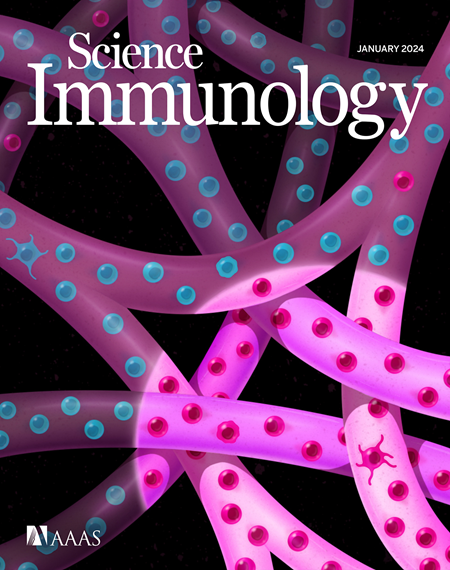LRIG1 engages ligand VISTA and impairs tumor-specific CD8+ T cell responses
IF 17.6
1区 医学
Q1 IMMUNOLOGY
引用次数: 0
Abstract
Immune checkpoint blockade is a promising approach to activate antitumor immunity and improve the survival of patients with cancer. V-domain immunoglobulin suppressor of T cell activation (VISTA) is an immune checkpoint target; however, the downstream signaling mechanisms are elusive. Here, we identify leucine-rich repeats and immunoglobulin-like domains 1 (LRIG1) as a VISTA binding partner, which acts as an inhibitory receptor by engaging VISTA and suppressing T cell receptor signaling pathways. Mice with T cell–specific LRIG1 deletion developed superior antitumor responses because of expansion of tumor-specific cytotoxic T lymphocytes (CTLs) with increased effector function and survival. Sustained tumor control was associated with a reduction of quiescent CTLs (TCF1+ CD62Lhi PD-1low) and a reciprocal increase in progenitor and memory-like CTLs (TCF1+ PD-1+). In patients with melanoma, elevated LRIG1 expression on tumor-infiltrating CD8+ CTLs correlated with resistance to immunotherapies. These results delineate the role of LRIG1 as an inhibitory immune checkpoint receptor and propose a rationale for targeting the VISTA/LRIG1 axis for cancer immunotherapy.
LRIG1 与配体 VISTA 结合,损害肿瘤特异性 CD8 + T 细胞反应
免疫检查点阻断是激活抗肿瘤免疫力和提高癌症患者生存率的一种很有前景的方法。V域免疫球蛋白T细胞活化抑制因子(VISTA)是一种免疫检查点靶点;然而,其下游信号机制却难以捉摸。在这里,我们发现富亮氨酸重复序列和免疫球蛋白样结构域1(LRIG1)是VISTA的结合伙伴,它作为抑制受体与VISTA结合并抑制T细胞受体信号通路。由于肿瘤特异性细胞毒性 T 淋巴细胞(CTL)扩增,效应功能增强,存活率提高,因此缺失 T 细胞特异性 LRIG1 的小鼠产生了卓越的抗肿瘤反应。肿瘤的持续控制与静止 CTL(TCF1 + CD62L hi PD-1 low)的减少以及祖细胞和记忆样 CTL(TCF1 + PD-1 +)的对等增加有关。在黑色素瘤患者中,肿瘤浸润 CD8 + CTL 上 LRIG1 表达的升高与免疫疗法的抗药性相关。这些结果阐明了 LRIG1 作为抑制性免疫检查点受体的作用,并提出了针对 VISTA/LRIG1 轴进行癌症免疫疗法的理论依据。
本文章由计算机程序翻译,如有差异,请以英文原文为准。
求助全文
约1分钟内获得全文
求助全文
来源期刊

Science Immunology
Immunology and Microbiology-Immunology
CiteScore
32.90
自引率
2.00%
发文量
183
期刊介绍:
Science Immunology is a peer-reviewed journal that publishes original research articles in the field of immunology. The journal encourages the submission of research findings from all areas of immunology, including studies on innate and adaptive immunity, immune cell development and differentiation, immunogenomics, systems immunology, structural immunology, antigen presentation, immunometabolism, and mucosal immunology. Additionally, the journal covers research on immune contributions to health and disease, such as host defense, inflammation, cancer immunology, autoimmunity, allergy, transplantation, and immunodeficiency. Science Immunology maintains the same high-quality standard as other journals in the Science family and aims to facilitate understanding of the immune system by showcasing innovative advances in immunology research from all organisms and model systems, including humans.
 求助内容:
求助内容: 应助结果提醒方式:
应助结果提醒方式:


